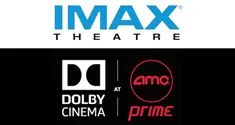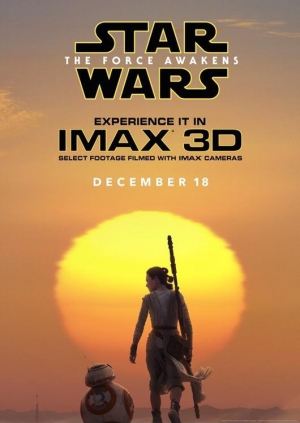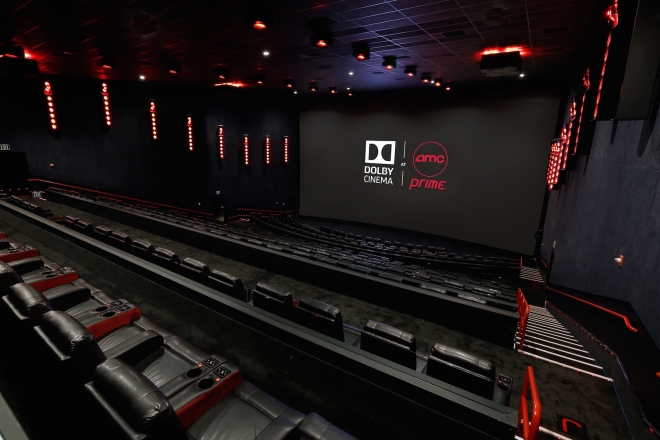
Posted Thu Dec 24, 2015 at 05:00 PM PST by Michael S. Palmer
A long, long time ago in our very own galaxy, 'Star Wars' wowed audiences around the world by fusing classical mythology and old Hollywood serial storytelling with cutting edge production techniques. As creator George Lucas wove his interstellar family saga, he helped pioneer what was cinematically possible, visually and aurally. He also fought to ensure presentation quality for as many cinema-goers as possible. To do this, he sometimes partnered with companies like Dolby Laboratories, for immersive audio, or Sony, to push the boundaries of digital filmmaking. Other times he founded his own companies, including ILM, THX, and Skywalker Sound. Either way, 'Star Wars' is more than a movie. It is a cinematic universe. A springboard for toys and other merchandize. And it is a guarantee that audiences are still going to be wowed, even forty years later, with the latest production and exhibition innovations.
As 2015 comes to an end, and with the staggering launch of 'The Force Awakens' this last weekend, I thought it would be fun to compare and contrast what are arguably the two best exhibition formats available today: IMAX and Dolby Cinema.
First developed in the 1960s, IMAX is synonymous with big screens and big sound. In the beginning, science museums played documentaries captured in 15-perf 70mm film ("15/70"). The effect, at times, was nothing short of going on a roller coaster ride. In the early 2000s, IMAX ventured into exhibiting Hollywood feature films thanks to a remastering technique allowing conventionally photographed film projects to be uprezzed for IMAX. Soon filmmakers like Christopher Nolan would shoot portions of their movies on IMAX cameras. IMAX also forged a partnership with AMC Theaters to retrofit large auditoriums into IMAX Digital screens using a dual 2K projection system aimed at screens not quite as grand as those capable of showing 15/70. This, of course, happened as the whole film exhibition industry converted from film to digital. During much of this time, IMAX stuck with a proprietary 5.1 surround sound system that includes large full range speakers and massive amounts of power.
Earlier this year, IMAX debuted two new technologies. On the visual front, they launched IMAX Laser and IMAX Laser 3D. This system uses dual 4K laser projectors that are 50% brighter than traditional digital projectors while offering Rec.2020 color gamut capability and double the contrast ratio of 15/70 IMAX film. This means brighter whites, deeper blacks, and more lifelike and saturated colors. On the sound front, IMAX has developed a 12-channel surround sound system that takes their previous 5.1 setup and adds two side-surround and four ceiling-surround speaker channels. For those familiar with Dolby Atmos, it is effectively a 7.0.5 configuration with large full range speakers and massive amounts of power. IMAX Laser 3D is among the first group of projectors that allow for true 3D projection at a 4K resolution. While previous generations were capped at 2K, next gen dual-headed laser projection systems -- like the Christie® 6P which was installed at the Seattle Cinerama and the Arclight Hollywood Cinerama Dome -- are changing the game. Which brings me to our other laser projection system:
Dolby Laboratories is synonymous with high quality audio and surround sound. Founded by Ray Dolby 50 years ago, the company started with noise reduction, moved on to stereo and stereo surround, and then developed AC-3 or Dolby Digital in the 1990s where the codec was used for theatrical exhibition, home entertainment products like DVDs, and finally as the broadcast standard for HDTV. The company has also developed 3D projection systems as well as advanced multi-channel and object-based surround sound system technologies. Basically, thanks to Dolby, you can now see a movie in theatres mixed in the ultra immersive Dolby Atmos format and then, months later, watch that movie on Blu-ray with the exact same mix tuned for your living room.
For 2015, Dolby launched Dolby Cinema, a premium large screen exhibition format. While standalone Dolby Cinema locations first debuted in Europe, Dolby partnered with AMC Theaters here in the United States for the initial rollout. We covered this in our post, HDD First Look: Dobly Cinema at AMC Prime, but the short version is this: AMC is retrofitting existing ETX and AMC Prime auditoriums into Dolby Cinema auditoriums. This combines large screens and lush leather recliners with two key Dolby technologies. Dolby Atmos handles the sound and boasts individual speaker amplification for pin-point sound placement, added full-range speakers, more subwoofers, and ceiling speakers. Dolby Atmos doesn't just surround listeners; it envelops them in a hemisphere of sound. Dolby Cinema visuals are handled by a new Dolby Vision projection technology that was developed with Christie®. This dual 4K laser projection offers a million to one contrast ratio, 31fL of light (twice conventional projection systems), and an expanded HDR color gamut capable of Rec.2020. Like IMAX Laser, this projection system is incredibly bright and accurate, with extraordinary black level and color reproduction capabilities. However, it is noted that "Dolby Cinema at AMC Prime" locations will be 2D-only.
I saw 'Star Wars: The Force Awakens' twice over the weekend. My first screening was at the historic TCL Chinese Theatre, which was not only the location of the first 'Star Wars' premiere in 1977, but also boasts the second largest screen in North America, IMAX Laser 3D projection, and 12-Channel Surround Sound. One day later, I snagged a ticket to Dolby Cinema at AMC Prime's newly opened Century City location, which is the second one in the Los Angeles area and ninth overall in the country. My initial idea for this article was to pit the two theatres against one another and declare a winner. But at the end of the day they're both exceptional ways to see movies and I'll eagerly buy tickets to both.
Regardless, I thought it would be fun to break down how each theatre handled the movie along with any observed strengths and weaknesses. It goes without saying that this isn't a very scientific experiment, since there was a 24-hour delay between screenings, I'm comparing 3D to 2D, and because your local IMAX and Dolby Cinema locations may have slight visual and acoustical variations versus the ones I visited.
 SIZE & SCOPE
SIZE & SCOPEIn comparing IMAX to Dolby Cinema, size is going to vary by location. In Los Angeles, the TCL Chinese IMAX is the Starkiller Base; its 94' x 46' screen offers an absolutely engulfing experience. Dolby Cinema at AMC Prime offers a wonderfully large screen (north of 60 feet, I believe) and terrific visual experience that's slightly smaller than IMAX, but one where every seat feels like a sweet spot.
'The Force Awakens' was primarily shot on 35mm film and mastered digitally in 4K for both IMAX and Dolby Vision. It is presented in a continuous 2.35:1 (or 2.40:1) aspect ratio despite one sequence being filmed on IMAX cameras. The 3D was converted by Stereo 3D, who also converted 'Titanic', 'Jurassic Park', 'Pacific Rim', and the more recent Marvel movies including 'Winter Soldier' and 'Guardians'. As we're dealing with 3D and 2D, it's a little unfair to compare the two formats as a contest. What I will say, however, is that 'Episode VII' offers an engaging sense of depth, dimensionality, color, and resolution in both formats. The effects work is generally spectacular, though some of the CGI felt a little light. Also, there is some softness inherent to the production, particularly in close ups of Carrie Fisher, visible in both formats. Either way, this is a very attractive movie that will look awesome on Blu-ray and Ultra HD Blu-ray. Ducking into non-laser auditoriums over the weekend, the movie looked very good, but brightness, color saturation, and black-levels were much stronger in both IMAX and Dolby Cinema.
The IMAX 3D conversion is a stunner. The added sense of depth sucks you into the Star Wars universe like never before and there's a real sensation of flying in many of the action sequences. My favorite shot, however, involved a Star Destroyer jutting out into the audience. It was so lifelike I almost tried to touch it. Brightness was very good for 3D, and black-levels are surprisingly deep at the expense of some minor crush.
Dolby Cinema's presentation is excellent too. Though the letterboxing above and below the screen could have been a truer black (minor nitpick alert!), the real strength of Dolby Vision is overall dynamic range. All of the film's sets and different worlds seemed incredibly lifelike and present. Colors were extremly rich, and shadow details were extraordinary, particularly on space ships and other darkly lit interior sets. I was also taken by how Dolby Vision reproduced bright objects such as explosions, offering improved details within the visual effects rendering.
In terms of nitpicks, neither of my two screening venues were able to display visible details of Adam Driver's dark hair towards the end of Kylo Ren's confrontation with Han Solo (black hair above a black costume in front of a dark wall is one hell of a challenge, I assume), but my guess is that this is likely due to color grading choices, ie filmmaker intention.
'Star Wars: The Force Awakens' Red Carpet World Premiere from Dolby Laboratories on Vimeo.
'Star Wars: The Force Awakens' has been encoded in multiple surround sound formats. Some of you will experience the film in 5.1 or 7.1 or one of the new object-based surround sound systems. As described above, the TCL Chinese IMAX is configured with 12-channel surround, while the Dolby Cinema at AMC Prime offers Dolby Atmos. I'm not sure of the exact configuration, but there were at least eight pairs of speakers and four subs mounted to the ceiling, as well as a two dozen or so speakers mounted on the walls and behind the screen.
 This was my first time screening an IMAX film with height speakers and I have to say I couldn't really tell. I was seated close to the screen, so perhaps the front channels overwhelmed the sensation of overhead immersion. That aside, the IMAX sound mix is excellent. I enjoyed the overall tone of this system, felt it hand a excllent low end grunt, and preferred this auditorium's speakers over those in Century City. IMAX has always been known for powerful sound and this one replicated all frequencies in an enveloping way.
This was my first time screening an IMAX film with height speakers and I have to say I couldn't really tell. I was seated close to the screen, so perhaps the front channels overwhelmed the sensation of overhead immersion. That aside, the IMAX sound mix is excellent. I enjoyed the overall tone of this system, felt it hand a excllent low end grunt, and preferred this auditorium's speakers over those in Century City. IMAX has always been known for powerful sound and this one replicated all frequencies in an enveloping way.
The Dolby Atmos mix was much more accurate at surround panning and world building immersion. X-Wing and TIE Fighter dogfights came to life in an incredible way, with laser blasts exploding overhead. This mix also has some wonderful quiet moments -- forest scenes evoke animals in the trees and wind whips through empty cavernous spaces and snow blows with delicate fury. It's all very lifelike, and a reminder that Dolby Atmos is more than just brute power; it's also precise in a way I've not heard in any other commercial sound system. The other thing Dolby Cinema at AMC Prime has going for it is in-seat transducers. You can't beat a rumbling seat for every boom, rattle, and bang. I suppose some might find it distracting, but to me it makes the LFE come to life.
My only nitpick on the audio side is related to this particular theatre, which I personally think has always been a little bright. A minor complaint only because I've been fortunate enough to demo material at professional Dolby Atmos mixing stages and because the Burbank Dolby Cinema at AMC Prime is hands down the best sounding commercial cinema in my area.
Whether you go with IMAX or Dolby Cinema, you're in for a reference quality sound mix that's sure to make for excellent demo material in the home. We can only hope Disney elects to use the Dolby Atmos mix on Blu-ray (something Disney has yet to do).
I attended a matinee for each screening, which might not be reflective of full adult pricing. Either way, these are premium tickets. I paid $19.50 to see 'The Force Awakens' in IMAX Laser 3D, and $18.59 to see it in Dolby Cinema at AMC Prime. I only saw one cell phone come out in each screening, thank the maker.
The TCL Chinese IMAX is the type of theatre you must-must visit if you ever come to Los Angeles. It is a one-screen palace where stars -- young, old, and wars -- have attended premieres for almost ninety years. Where your favorite actors have their hands and feet stamped into cement. The auditorium is luxuriously appointed, adorned with artwork and carvings and miles of red velvet. It has always offered state-of-the-art projection and sound, but as an IMAX, it's world class. The seats are all brand new, and fairly comfortable. The food typical of any movie theatre in the country. The location, while fun for tourists, is a bit of a pain to access because of all those fun-having tourists. The one bummer here: there is an aisle where one might place the best -- centered -- seats in the house. I'm sure it was about balancing fire code with maximizing the number of seats, but for shame.
The AMC Century City 15 takes up the corner of an upscale mall on the west side of Los Angeles. It too can be challenging to access, but only during peak shopping seasons. However, unlike Hollywood, unless you work in one of the neighboring high rises, there's little to do nearby. Visually speaking, this auditorium doesn't offer the full experience of the Burbank location (no video wall as you enter, and it didn't have lit speaker lights before the show), but reserved leather recliners are pretty much the best way to see movies ever. I only wish there was enough room to extend the foot rests a little more. Food offerings are plentiful, but it's not as good as AMC's Dine-In locations (which I love).

I set out this weekend to crown a cinema king by pitting two great theatres against one another, but instead came away in awe of both. Dual 4K laser projection systems capable of HDR and Rec.2020, with double the brightness of conventional digital projection, are the future. IMAX offers an unparalleled sense of scope, while Dolby Cinema offers an incredible about of fidelity in its visual dynamic range -- strong colors, a bright image, and loads of shadow detail. Again, it's important to remember this is partially an apples to oranges comparision because I wasn't able to compare two 2D sources, so there is more experimenting to be done, much of it subjective. In terms of sound, Dolby Atmos immerses the audience with an articulate and specific sense of world-building, and IMAX offers a wonderfully, deep sonic experience. Lastly, both of these theatres offer excellent movie-going experiences.
At the end of the day, both formats represent tremendous value to film fans who want to experience something home cinemas will never be able to fully replicate. The TCL Chinese IMAX is a must-visit historic location (there's only one), while Dolby Cinema is a must-experience theatrical auditorium (and hopefully AMC is building one near you now). To locate a theatre in your area playing IMAX Laser 3D, click HERE. To find Dolby Cinema at AMC Prime locations, click HERE.
***
Did you see 'The Force Awakens' this weekend? Let us know what format(s) you experienced and what you thought below or in our forums. Cheers.
NOTE: This article has been updated to correct a few facts and clarify language.
See what people are saying about this story in our forums area, or check out other recent discussions.
The latest news on all things 4K Ultra HD, blu-ray and Gear.